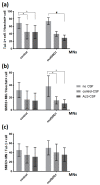Human Spinal Motor Neurons Are Particularly Vulnerable to Cerebrospinal Fluid of Amyotrophic Lateral Sclerosis Patients
- PMID: 32443559
- PMCID: PMC7278966
- DOI: 10.3390/ijms21103564
Human Spinal Motor Neurons Are Particularly Vulnerable to Cerebrospinal Fluid of Amyotrophic Lateral Sclerosis Patients
Abstract
Amyotrophic lateral sclerosis (ALS) is the most common and devastating motor neuron (MN) disease. Its pathophysiological cascade is still enigmatic. More than 90% of ALS patients suffer from sporadic ALS, which makes it specifically demanding to generate appropriate model systems. One interesting aspect considering the seeding, spreading and further disease development of ALS is the cerebrospinal fluid (CSF). We therefore asked whether CSF from sporadic ALS patients is capable of causing disease typical changes in human patient-derived spinal MN cultures and thus could represent a novel model system for sporadic ALS. By using induced pluripotent stem cell (iPSC)-derived MNs from healthy controls and monogenetic forms of ALS we could demonstrate a harmful effect of ALS-CSF on healthy donor-derived human MNs. Golgi fragmentation-a typical finding in lower organism models and human postmortem tissue-was induced solely by addition of ALS-CSF, but not control-CSF. No other neurodegenerative hallmarks-including pathological protein aggregation-were found, underpinning Golgi fragmentation as early event in the neurodegenerative cascade. Of note, these changes occurred predominantly in MNs, the cell type primarily affected in ALS. We thus present a novel way to model early features of sporadic ALS.
Keywords: ALS; Golgi fragmentation; amyotrophic lateral sclerosis; cerebrospinal fluid; fused in sarcoma; superoxide dismutase 1.
Conflict of interest statement
The authors declare no conflict of interest.
Figures






Similar articles
-
Cerebrospinal fluid from amyotrophic lateral sclerosis patients causes fragmentation of the Golgi apparatus in the neonatal rat spinal cord.Amyotroph Lateral Scler. 2007 Apr;8(2):79-82. doi: 10.1080/08037060601145489. Amyotroph Lateral Scler. 2007. PMID: 17453633
-
Distinct responses of neurons and astrocytes to TDP-43 proteinopathy in amyotrophic lateral sclerosis.Brain. 2020 Feb 1;143(2):430-440. doi: 10.1093/brain/awz419. Brain. 2020. PMID: 32040555 Free PMC article.
-
Evidence of endoplasmic reticular stress in the spinal motor neurons exposed to CSF from sporadic amyotrophic lateral sclerosis patients.Neurobiol Dis. 2011 Mar;41(3):695-705. doi: 10.1016/j.nbd.2010.12.005. Epub 2010 Dec 16. Neurobiol Dis. 2011. PMID: 21168498
-
Reverse engineering human neurodegenerative disease using pluripotent stem cell technology.Brain Res. 2016 May 1;1638(Pt A):30-41. doi: 10.1016/j.brainres.2015.09.023. Epub 2015 Sep 28. Brain Res. 2016. PMID: 26423934 Free PMC article. Review.
-
A novel hypothesis on metal dyshomeostasis and mitochondrial dysfunction in amyotrophic lateral sclerosis: Potential pathogenetic mechanism and therapeutic implications.Eur J Pharmacol. 2021 Feb 5;892:173737. doi: 10.1016/j.ejphar.2020.173737. Epub 2020 Nov 19. Eur J Pharmacol. 2021. PMID: 33220280 Review.
Cited by
-
40 Years of CSF Toxicity Studies in ALS: What Have We Learnt About ALS Pathophysiology?Front Mol Neurosci. 2021 Mar 18;14:647895. doi: 10.3389/fnmol.2021.647895. eCollection 2021. Front Mol Neurosci. 2021. PMID: 33815058 Free PMC article. Review.
-
Corrosion Products from Metallic Implants Induce ROS and Cell Death in Human Motoneurons In Vitro.J Funct Biomater. 2023 Jul 25;14(8):392. doi: 10.3390/jfb14080392. J Funct Biomater. 2023. PMID: 37623637 Free PMC article.
-
Defining novel functions for cerebrospinal fluid in ALS pathophysiology.Acta Neuropathol Commun. 2020 Aug 20;8(1):140. doi: 10.1186/s40478-020-01018-0. Acta Neuropathol Commun. 2020. PMID: 32819425 Free PMC article. Review.
-
Cerebrospinal fluid cytotoxicity in amyotrophic lateral sclerosis: a systematic review of in vitro studies.Brain Commun. 2020 Aug 6;2(2):fcaa121. doi: 10.1093/braincomms/fcaa121. eCollection 2020. Brain Commun. 2020. PMID: 33094283 Free PMC article. Review.
-
Storage of Mutant Human SOD1 in Non-Neural Cells from the Type-1 Amyotrophic Lateral Sclerosis ratG93A Model Correlated with the Lysosomes' Dysfunction.Biomedicines. 2021 Aug 24;9(9):1080. doi: 10.3390/biomedicines9091080. Biomedicines. 2021. PMID: 34572266 Free PMC article.
References
-
- Gomez-Pinedo U., Galan L., Yanez M., Matias-Guiu J., Valencia C., Guerrero-Sola A., Lopez-Sosa F., Brin J.R., Benito-Martin M.S., Leon-Espinosa G., et al. Histological changes in the rat brain and spinal cord following prolonged intracerebroventricular infusion of cerebrospinal fluid from amyotrophic lateral sclerosis patients are similar to those caused by the disease. Neurologia. 2018;33:211–223. doi: 10.1016/j.nrleng.2016.07.002. - DOI - PubMed
-
- Gomez-Pinedo U., Yanez M., Matias-Guiu J., Galan L., Guerrero-Sola A., Benito-Martin M.S., Vela A., Arranz-Tagarro J.A., Garcia A.G. Cellular changes in motor neuron cell culture produced by cytotoxic cerebrospinal fluid from patients with amyotrophic lateral sclerosis. Neurologia. 2014;29:346–352. doi: 10.1016/j.nrl.2013.08.001. - DOI - PubMed
MeSH terms
Supplementary concepts
Grants and funding
LinkOut - more resources
Full Text Sources
Medical
Miscellaneous

